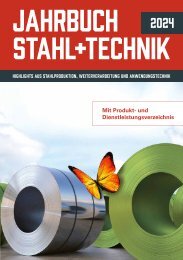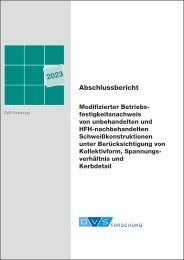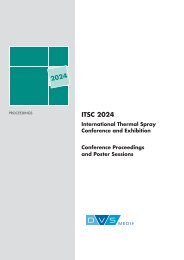STEEL + TECHNOLOGY 04/2019 EXTRACT
STEEL + TECHNOLOGY 04/2019 EXTRACT
STEEL + TECHNOLOGY 04/2019 EXTRACT
You also want an ePaper? Increase the reach of your titles
YUMPU automatically turns print PDFs into web optimized ePapers that Google loves.
<strong>STEEL</strong> <strong>TECHNOLOGY</strong> | 51<br />
Robotics and automation. Design of a<br />
modern casthouse is driven by layout and<br />
logistical optimization, dust and fumes<br />
reduction, and the use of robots in labor-intensive<br />
and repetitive tasks. Process efficiency<br />
is enhanced, by eliminating human<br />
error and implementing the best operational<br />
practices, and workplace is cleaner and<br />
safer, with lower need of maintenance.<br />
Maintenance represents a cost and a<br />
loss in productivity. Minimization is desirable<br />
but only on a smart basis. While externals<br />
are constantly under inspection, condition<br />
assessment of internals requires<br />
dedicated and sophisticated simulations of<br />
wear patterns. Risk mitigation and projected<br />
remaining lifetime concepts produce an<br />
adjustment of maintenance scheduling.<br />
Failures are greatly reduced, stoppages for<br />
maintenance are delayed, and new layouts<br />
are designed to improve maintenance<br />
while reducing time and cost.<br />
Gas cleaning. With reagent injection and<br />
a pressurized bag filter, BF dry scrubbing<br />
produces an effective abatement of emissions.<br />
No water consumption and<br />
improved power plant efficiency are the<br />
two indisputable advantages.<br />
BOF gas scrubbers, including a pre-humidification<br />
step and performing the<br />
scrubbing in a variable-section, annular<br />
scrubber increases the gas-liquid contact<br />
and the abatement efficiency, while<br />
decreasing the pressure drop.<br />
Figure 3. Pump room of the cooling water treatment circuit at Acciaierie di Verona<br />
(Pittini Group), which serves the Danieli FastCast six-strand billet caster and the<br />
two-strand wire rod mill with a 750,000-tpy capacity (Picture: Danieli)<br />
DRI. Ultra-low NO x burners will keep process<br />
NO x emissions below 25-30 ppm.<br />
Where limits are more stringent, a selective<br />
catalytic reactor (SCR) can bring emissions<br />
below 10 ppm. The carbon footprint<br />
of a DR-EAF plant is about 50% of that of<br />
an integrated mill; however, among the<br />
available DR technologies, the Energiron<br />
ZR has the possibility to selectively capture<br />
the CO 2 generated by the reduction of<br />
iron ores and this leads to a reduction in<br />
emissions by a further 60%, ready for storage<br />
or reuse, according to available CCS<br />
and CCU technologies. If hydrogen is added<br />
to the process in partial substitution of<br />
natural gas, CO 2 emissions can be significantly<br />
reduced.<br />
The Energiron ZR is highly optimized,<br />
with 78% process efficiency. Further<br />
improvement in the ZR-EAF production<br />
route is possible by charging the hot DRI<br />
to the EAF. Through pneumatic transportation<br />
with non-oxidizing gas, the hot DRI<br />
reaches the EAF charging bins at 600°C,<br />
thus saving energy and TTT. Furthermore,<br />
carbon content of DRI is 100% available to<br />
complete the reduction of DRI and gives<br />
some extra chemical energy to the EAF<br />
melting process.<br />
EAF steelmaking<br />
ECS horizontal continuous-charging scrap<br />
preheater reduces melting energy and TTT<br />
while keeping CO, dioxins, NO x and VOC<br />
under control. Keeping the roof closed, the<br />
FTP is simpler and more efficient, and<br />
GHG emissions are reduced -7% compared<br />
to bucket charging.<br />
Danieli Automation tools like Q-Melt<br />
Automatic EAF adaptive process control<br />
and Q-SYM automatic scrap-yard management<br />
platform comply with the Industry<br />
4.0 approach. Charging and melting are<br />
controlled automatically and continuously,<br />
for consistent steel quality at minimal cost.<br />
Q-One power management for conventional<br />
AC EAFs addresses problems<br />
caused by reactive power, flicker and harmonics<br />
to the network. Based on control<br />
capabilities provided by power electronic<br />
semiconductors, Q-One reduces EAF<br />
overall electric power consumption with a<br />
shorter power-on time, and lower electrode<br />
consumption. It is a modular system<br />
that can be implemented on new or existing<br />
AC EAFs, meaning that the EAF no<br />
longer requires transformers or SVC filters<br />
to perform reliably, and its modularity<br />
allows easy expansion when more power<br />
is required.<br />
Fume treating. Pulse-Jet Bag Filters are<br />
the BAT to minimize the residual dust content<br />
both at the stack outlet and in working<br />
<strong>STEEL</strong> + <strong>TECHNOLOGY</strong> 1 (<strong>2019</strong>) No. 4


















